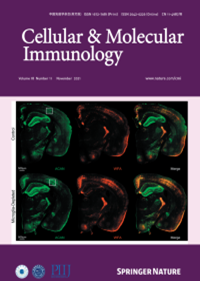从天然受体到合成受体的转变:扩展t细胞工程及其他。
IF 19.8
1区 医学
Q1 IMMUNOLOGY
引用次数: 0
摘要
t细胞免疫治疗发展迅速,从原生t细胞受体生物学发展到创新的合成受体,将治疗应用扩展到癌症以外。这篇综述探讨了从天然tcr到合成受体的工程策略,以增加t细胞的活化和治疗潜力。我们首先强调天然受体在t细胞反应中的基础作用,强调这些结构和功能的见解如何为下一代合成受体的设计提供信息。CAR和tcr样合成受体的比较强调了它们各自在特异性、有效性和安全性方面的优势,以及进一步改进的潜在领域。此外,CRISPR-Cas9等基因编辑技术能够精确修饰t细胞基因组,提高受体性能并最大限度地降低免疫原性风险。除了肿瘤,这些工程T细胞还可以直接对抗病毒感染、自身免疫性疾病和其他疾病。我们还探索了涉及多种免疫细胞类型的先进策略,以实现协同,持久的反应。通过展示天然受体和合成受体如何共同推动创新,本综述旨在激发新的研究方向,并最终扩大t细胞工程的普遍治疗应用范围。本文章由计算机程序翻译,如有差异,请以英文原文为准。

Transitioning from native to synthetic receptors: broadening T-cell engineering and beyond
T-cell immunotherapy has progressed rapidly, evolving from native T-cell receptor biology to the development of innovative synthetic receptors that extend therapeutic applications beyond cancer. This review explores engineering strategies, ranging from natural TCRs to synthetic receptors, that increase T-cell activation and therapeutic potential. We begin by highlighting the foundational role of native receptors in the T-cell response, emphasizing how these structural and functional insights inform the design of next-generation synthetic receptors. Comparisons between CAR and TCR-like synthetic receptors underscore their respective advantages in specificity, efficacy, and safety, as well as potential areas for further improvement. In addition, gene editing technologies such as CRISPR-Cas9 enable precise modifications to the T-cell genome, enhancing receptor performance and minimizing immunogenic risks. In addition to tumors, these engineered T cells can be directed against viral infections, autoimmune disorders, and other diseases. We also explore advanced strategies that engage multiple immune cell types to achieve synergistic, durable responses. By demonstrating how native and synthetic receptors collectively drive innovation, this review aims to inspire new research directions and ultimately expand the scope of T-cell engineering for universal therapeutic applications.
求助全文
通过发布文献求助,成功后即可免费获取论文全文。
去求助
来源期刊
CiteScore
31.20
自引率
1.20%
发文量
903
审稿时长
1 months
期刊介绍:
Cellular & Molecular Immunology, a monthly journal from the Chinese Society of Immunology and the University of Science and Technology of China, serves as a comprehensive platform covering both basic immunology research and clinical applications. The journal publishes a variety of article types, including Articles, Review Articles, Mini Reviews, and Short Communications, focusing on diverse aspects of cellular and molecular immunology.

 求助内容:
求助内容: 应助结果提醒方式:
应助结果提醒方式:


